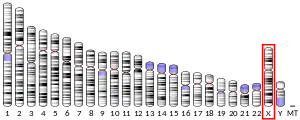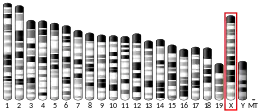NOX1
NADPH oxidase 1 is an enzyme that in humans is encoded by the NOX1 gene.[5]
NOX1 is a homolog of the catalytic subunit of the superoxide-generating NADPH oxidase of phagocytes, gp91phox. Two transcript variants encoding different isoforms have been found for this gene.[6]
References
- GRCh38: Ensembl release 89: ENSG00000007952 - Ensembl, May 2017
- GRCm38: Ensembl release 89: ENSMUSG00000031257 - Ensembl, May 2017
- "Human PubMed Reference:". National Center for Biotechnology Information, U.S. National Library of Medicine.
- "Mouse PubMed Reference:". National Center for Biotechnology Information, U.S. National Library of Medicine.
- Suh YA, Arnold RS, Lassegue B, Shi J, Xu X, Sorescu D, Chung AB, Griendling KK, Lambeth JD (Sep 1999). "Cell transformation by the superoxide-generating oxidase Mox1". Nature. 401 (6748): 79–82. Bibcode:1999Natur.401...79S. doi:10.1038/43459. PMID 10485709. S2CID 4365361.
- "Entrez Gene: NOX1 NADPH oxidase 1".
Further reading
- Lachgar A, Sojic N, Arbault S, et al. (1999). "Amplification of the inflammatory cellular redox state by human immunodeficiency virus type 1-immunosuppressive tat and gp160 proteins". J. Virol. 73 (2): 1447–52. doi:10.1128/JVI.73.2.1447-1452.1999. PMC 103969. PMID 9882350.
- Kikuchi H, Hikage M, Miyashita H, Fukumoto M (2000). "NADPH oxidase subunit, gp91(phox) homologue, preferentially expressed in human colon epithelial cells". Gene. 254 (1–2): 237–43. doi:10.1016/S0378-1119(00)00258-4. PMID 10974555.
- Dahlgren C, Karlsson A (2002). "Ionomycin-induced neutrophil NADPH oxidase activity is selectively inhibited by the serine protease inhibitor diisopropyl fluorophosphate". Antioxid. Redox Signal. 4 (1): 17–25. doi:10.1089/152308602753625816. PMID 11970839.
- Babior BM (2002). "The activity of leukocyte NADPH oxidase: regulation by p47PHOX cysteine and serine residues". Antioxid. Redox Signal. 4 (1): 35–8. doi:10.1089/152308602753625834. PMID 11970841.
- Strausberg RL, Feingold EA, Grouse LH, et al. (2003). "Generation and initial analysis of more than 15,000 full-length human and mouse cDNA sequences". Proc. Natl. Acad. Sci. U.S.A. 99 (26): 16899–903. Bibcode:2002PNAS...9916899M. doi:10.1073/pnas.242603899. PMC 139241. PMID 12477932.
- Geiszt M, Lekstrom K, Witta J, Leto TL (2003). "Proteins homologous to p47phox and p67phox support superoxide production by NAD(P)H oxidase 1 in colon epithelial cells". J. Biol. Chem. 278 (22): 20006–12. doi:10.1074/jbc.M301289200. PMID 12657628.
- Takeya R, Ueno N, Kami K, et al. (2003). "Novel human homologues of p47phox and p67phox participate in activation of superoxide-producing NADPH oxidases". J. Biol. Chem. 278 (27): 25234–46. doi:10.1074/jbc.M212856200. PMID 12716910.
- Geiszt M, Lekstrom K, Brenner S, et al. (2003). "NAD(P)H oxidase 1, a product of differentiated colon epithelial cells, can partially replace glycoprotein 91phox in the regulated production of superoxide by phagocytes". J. Immunol. 171 (1): 299–306. doi:10.4049/jimmunol.171.1.299. PMID 12817011.
- Chamulitrat W, Schmidt R, Tomakidi P, et al. (2003). "Association of gp91phox homolog Nox1 with anchorage-independent growth and MAP kinase-activation of transformed human keratinocytes". Oncogene. 22 (38): 6045–53. doi:10.1038/sj.onc.1206654. PMID 12955083.
- Cheng G, Lambeth JD (2004). "NOXO1, regulation of lipid binding, localization, and activation of Nox1 by the Phox homology (PX) domain". J. Biol. Chem. 279 (6): 4737–42. doi:10.1074/jbc.M305968200. PMID 14617635.
- Hilenski LL, Clempus RE, Quinn MT, et al. (2004). "Distinct subcellular localizations of Nox1 and Nox4 in vascular smooth muscle cells". Arterioscler. Thromb. Vasc. Biol. 24 (4): 677–83. doi:10.1161/01.ATV.0000112024.13727.2c. PMID 14670934.
- Morré DM, Guo F, Morré DJ (2004). "An aging-related cell surface NADH oxidase (arNOX) generates superoxide and is inhibited by coenzyme Q". Mol. Cell. Biochem. 254 (1–2): 101–9. doi:10.1023/A:1027301405614. PMID 14674687. S2CID 22933040.
- Chamulitrat W, Stremmel W, Kawahara T, et al. (2004). "A constitutive NADPH oxidase-like system containing gp91phox homologs in human keratinocytes". J. Invest. Dermatol. 122 (4): 1000–9. doi:10.1111/j.0022-202X.2004.22410.x. PMID 15102091.
- Goyal P, Weissmann N, Grimminger F, et al. (2004). "Upregulation of NAD(P)H oxidase 1 in hypoxia activates hypoxia-inducible factor 1 via increase in reactive oxygen species". Free Radic. Biol. Med. 36 (10): 1279–88. doi:10.1016/j.freeradbiomed.2004.02.071. PMID 15110393.
- Barbieri SS, Cavalca V, Eligini S, et al. (2005). "Apocynin prevents cyclooxygenase 2 expression in human monocytes through NADPH oxidase and glutathione redox-dependent mechanisms". Free Radic. Biol. Med. 37 (2): 156–65. doi:10.1016/j.freeradbiomed.2004.04.020. PMID 15203187.
- Guzik TJ, Sadowski J, Kapelak B, et al. (2005). "Systemic regulation of vascular NAD(P)H oxidase activity and nox isoform expression in human arteries and veins". Arterioscler. Thromb. Vasc. Biol. 24 (9): 1614–20. doi:10.1161/01.ATV.0000139011.94634.9d. PMID 15256399.
- Ambasta RK, Kumar P, Griendling KK, et al. (2004). "Direct interaction of the novel Nox proteins with p22phox is required for the formation of a functionally active NADPH oxidase". J. Biol. Chem. 279 (44): 45935–41. doi:10.1074/jbc.M406486200. PMID 15322091.
- Geiszt M, Lekstrom K, Leto TL (2005). "Analysis of mRNA transcripts from the NAD(P)H oxidase 1 (Nox1) gene. Evidence against production of the NADPH oxidase homolog-1 short (NOH-1S) transcript variant". J. Biol. Chem. 279 (49): 51661–8. doi:10.1074/jbc.M409325200. PMID 15375166.
This article is issued from Wikipedia. The text is licensed under Creative Commons - Attribution - Sharealike. Additional terms may apply for the media files.






